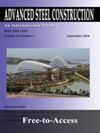冷成型高强度角钢的抗力
IF 1.7
3区 工程技术
Q3 CONSTRUCTION & BUILDING TECHNOLOGY
引用次数: 1
摘要
本文对冷弯高强度角钢的性能进行了研究。考虑了36个不同冷弯角度(90°、100°、120°、140°、160°和170°)和不同厚度(4 mm和6 mm)的试件。采用三维激光扫描方法确定了试样的初始几何缺陷。提出了扭转屈曲、扭转弯曲屈曲和弯曲屈曲分析中这些几何缺陷的大小。采用壳单元S4R的商业有限元分析程序ABAQUS进行有限元分析。在数值模型中考虑了不同的材料强度以及不同的抗应力(0.2%、0.01%和0.006%)。实验结果与有限元分析结果吻合较好。分析了冷弯角度对90°和120°冷弯角度下4mm厚柱无因次长细比和折减系数曲线的影响。本文章由计算机程序翻译,如有差异,请以英文原文为准。
RESISTANCE OF COLD FORMED HIGH STRENGTH STEEL ANGLES
This paper describes a study of the behaviour of cold-formed high strength steel angles. Thirty-six specimens with different cold-formed angles (90°, 100°, 120°, 140°, 160°, and 170°) and different thicknesses (4 mm and 6 mm) were considered. The initial geometric imperfections of the specimens were determined using the 3D laser scanning method. The magnitudes of these geometric imperfections for torsional and torsional-flexural buckling and flexural buckling analyses were proposed. The commercial finite element analysis (FEA) programme ABAQUS with shell elements S4R was used for finite element analyses. Different material strengths in corner and flat parts along with different proof stresses (0.2%, 0.01%, and 0.006%) were considered in the numerical models. The experimental and FEA results showed good agreement. Influence of cold-formed angle on non-dimensional slenderness and reduction factor curves of the 4 mm thick columns with 90° and 120° cold-formed angles was analysed.
求助全文
通过发布文献求助,成功后即可免费获取论文全文。
去求助
来源期刊

Advanced Steel Construction
CONSTRUCTION & BUILDING TECHNOLOGY-ENGINEERING, CIVIL
CiteScore
2.60
自引率
29.40%
发文量
0
审稿时长
6 months
期刊介绍:
The International Journal of Advanced Steel Construction provides a platform for the publication and rapid dissemination of original and up-to-date research and technological developments in steel construction, design and analysis. Scope of research papers published in this journal includes but is not limited to theoretical and experimental research on elements, assemblages, systems, material, design philosophy and codification, standards, fabrication, projects of innovative nature and computer techniques. The journal is specifically tailored to channel the exchange of technological know-how between researchers and practitioners. Contributions from all aspects related to the recent developments of advanced steel construction are welcome.
 求助内容:
求助内容: 应助结果提醒方式:
应助结果提醒方式:


